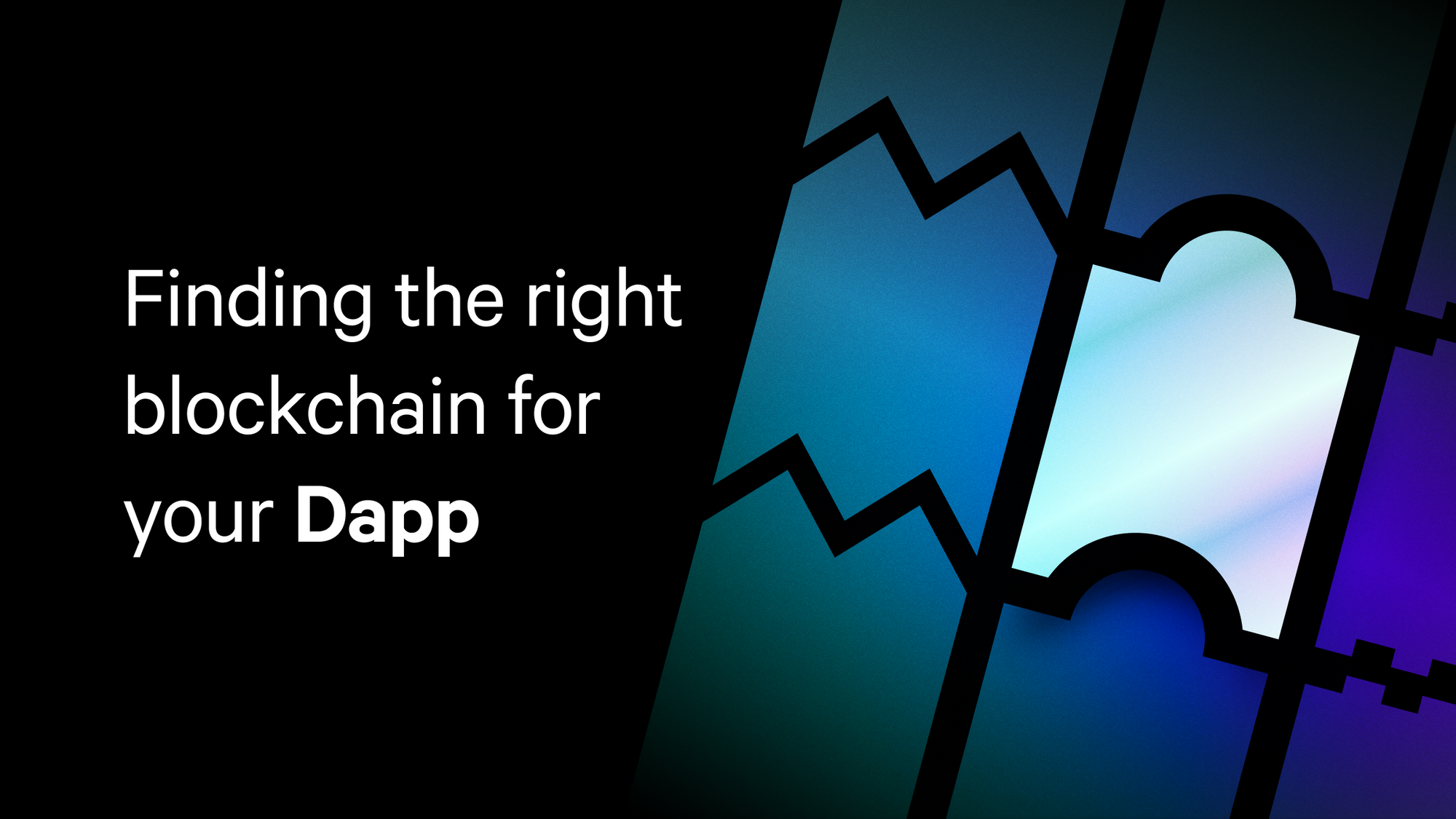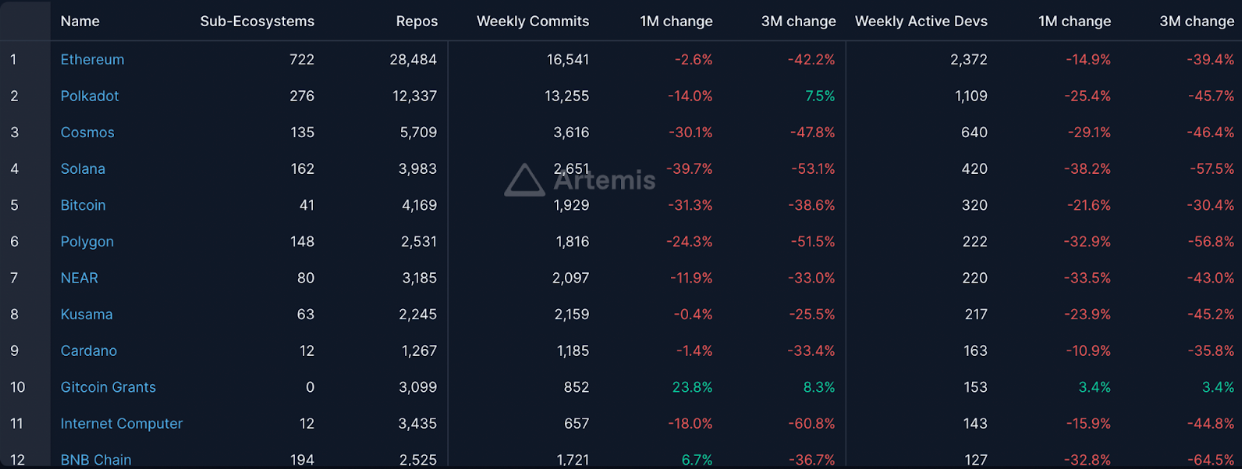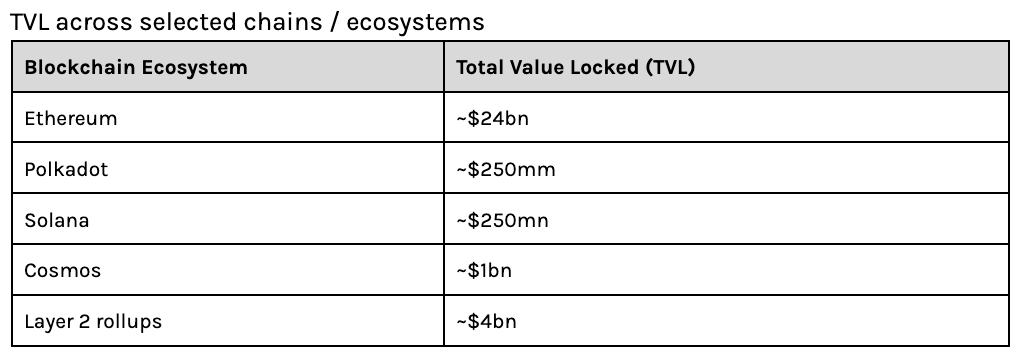How to Find the Right Blockchain For Your Dapp

The crypto ecosystem has grown at an exponential rate in the past several years, and so has the number of decentralized apps (Dapps) and the number of users and transactions on those Dapps. This presents a scalability challenge as the network capacity on blockchains like Ethereum struggles to keep up, and has resulted in a number of new blockchains — each designed to optimize for scalability without sacrificing decentralization and security (a trade-off known as the Blockchain Scalability Trilemma).
For project developers in Web3, one of the most important decisions is choosing what blockchain network to build on, and making sure it has the right tools and support to develop and scale your project.
In addition to scalability, decentralization, and security, a number of outside factors are also important for consideration, including but not limited to:
- Ecosystem network effects
- Customizability
- Composability
- Developer tooling
- Token value capture
As a result, builders now have a multitude of factors that they need to consider as they decide which ecosystem they should choose in which to develop and deploy their Dapp.
Over the last few years, three main categories of blockchain ecosystems have emerged for builders to choose from:
- Modular Layer 2 / execution layer rollups
- High-performance monolithic Alternative Layer 1 blockchains
- Interoperable AppChains and use-case specific chains
We explore the advantages and disadvantages of building Dapps in these respective categories below.
1. Execution Layers and Layer 2 Rollups: A modular approach to scaling
The influx of users and Dapps on Ethereum has exposed the limitations of the Ethereum mainnet blockchain. In response, the Ethereum ecosystem has gravitated towards the use of modular execution layers known as Layer 2 rollups. These rollups take a modular approach to scaling by disaggregating the core components of a blockchain (execution, settlement, consensus, and data availability). By aggregating and performing transaction execution outside Ethereum mainnet and posting these transactions at a fraction of the price on Ethereum mainnet, they are able to provide Ethereum-level security while enabling faster UX and lower costs for users.
Today, the two main categories of rollups on Ethereum are Optimistic rollups (ORUs) and ZK rollups (ZKRs) – more information on the design tradeoffs of their respective security models can be found here.

It is important to note that not all Layer 2 rollups are Ethereum-centric. While Ethereum has been the default settlement layer for most Layer 2 rollups due its superior security, there are still limitations to the scalability of its data availability layer.
The emergence of Celestia, a modular data-availability blockchain, has resulted in a new generation of execution layers (such as Fuel Labs and Eclipse) that utilize Celestia’s data availability layer as part of its modular stack, providing developers with a new set of execution-layer rollups that they can choose to deploy their Dapp.
Main Advantages of Execution and Layer 2 Rollups:
- Improved Scalability: By aggregating and taking executions off-chain, Layer 2 rollups are able to make significant improvements on throughput (measured in transactions per second, or TPS) compared to that of Ethereum. ZKRs, in particular, are particularly scalable as the network gets cheaper with increase in transaction volume. Some modular execution layers also utilize separate data availability layers like Celestia, which help to reduce transaction costs of the network and improve the UX experience for Dapp developers building on these rollups.
- Superior Security: By posting transactions to Ethereum mainnet, Layer 2s can leverage the security offered by Ethereum’s large validator base. This is especially important for security-sensitive Dapps building in the DeFi space.
- Existing Developer Tooling / Infrastructure: Ethereum Virtual Machine (EVM) compatibility and equivalence means that new teams building on Layer 2s can leverage Ethereum’s large developer community that is already familiar with the EVM and the Solidity programming language.
- Ethereum Network Effects: The EVM equivalence of Layer 2 rollups means that existing Dapps on mainnet can port over to Layer 2s with relative ease, allowing them to bring over users and liquidity from Ethereum mainnet. Dapp smart contracts on respective rollups are also composable with each other, meaning users can theoretically interact seamlessly with multiple protocols in the same transaction.
Main Drawbacks of Execution and Layer 2 Rollups
- Limited Interoperability: Interoperability between Layer 2 rollups and other Layer 1s is limited, resulting in fragmented liquidity for cross-chain Dapps and a less optimal UX experience for users.
- Poor Bridging and Withdrawal UX: For users wishing to withdraw their assets back to L1s, ORU bridges are both slow and expensive, and while cross-chain bridges have helped to address this UX issue, they have been particularly susceptible to hacks.
- Use of centralized sequencers: The use of centralized sequences in Layer 2 rollups, which have the ability to censor transactions, presents a legal and operational risk for teams that aim to optimize for decentralization. This was one of the reasons DyDx moved from putting its Dapp on a Layer 2 rollup to developing their own AppChain on Cosmos.
- Developer limitations of EVM: Most execution-based rollups today are EVM-based, and as a result, impose the same limitations and inefficiencies of the EVM (complexity of Solidity, inefficient execution design) that many Dapps on Ethereum mainnet face. That said, modular execution layers such as Fuel have begun to leverage the design space made possible by the modular stack by moving away from the EVM altogether (more details on the benefits of FuelVM and UTXO can be read here).
Best Suited For:
DeFi applications that have high security requirements and prefer the use of Ethereum as its settlement network. Given the limitation on cross-chain strategies, an existing ecosystem of other DeFi primitives on the native Layer 2 rollup will be crucial for teams seeking to build applications that benefit from composing with other Dapps (i.e. trade routing on DEX aggregators, flash loans and token hypothecation on borrowing protocols).
2. Alternative Layer 1 Blockchains: Optimizing for high performance through new design architectures
In the past few years, many teams have chosen to build outside the Ethereum ecosystem all together by building on new alternative Layer 1 blockchains (Alt L1s). As opposed to the modular approach taken by Ethereum Layer 2 rollups, these Alt L1s are monolithic, meaning they handle all the components of a blockchain (execution, settlement, consensus, and data availability).
These Alt L1s have been optimized for high performance by redesigning the existing architectures of monolithic blockchains. The implementation of innovative technical solutions — such as sharding or parallel execution — have allowed these blockchains to dramatically increase their throughput while limiting transaction costs, opening up a new set of design possibilities previously not available to builders on Ethereum mainnet.
As a result, many new protocols and Dapps have chosen to build directly on these Alt L1s over the last year. The Solana and NEAR blockchains, for example, have amassed large ecosystems of users and Dapps, while newer Alt L1s such as Mysten Lab’s Sui Blockchain have also attracted sizable mindshare for new Dapp developers.

Main Advantages of Alt L1s
- Superior Scalability: High performance Alt L1s have dramatically higher TPS compared to other blockchains, allowing for new primitives (such as blockchain games) to be built that would have been impossible otherwise.
- Large Ecosystem Development Funds / Grants: Many new Alt L1s come to market with large ecosystem funds or grants programs, incentivizing teams to build their Dapp on their Alt L1 network. This can be extremely useful for bootstrapping developer activity and community growth. A prominent example of this would be NEAR, which launched an $800m ecosystem fund last year to drive ecosystem growth.
- New developer / infrastructure tooling: Many of these chains have opted for new programming languages (for example, Solana’s Rust and Sui’s Move) that provide certain benefits over Ethereum’s Solidity. This allows for a new class of developers that can come to market with a new set of eyes and add something new to the Web 3 design space.
Main Drawbacks of Alt L1s:
- Security tradeoffs: While established Alt L1 blockchains have amassed large validator sets, new blockchains have to incentivize validators to come onto their platform to help secure the network. To compensate for this tradeoff, Alt L1s typically benefit from faster and cheaper transactions.
- Ecosystem isolation: Similar to those on Layer 2 roll ups, Dapps on monolithic Alt L1s have limited composability and interoperability with those on other Alt L1s, limiting Dapps that are dependent on cross-chain capabilities or seeking to attract liquidity away from Ethereum Mainnet.
- Limited Developer Base: Many of the new programming languages used by Alt L1s have higher learning curves versus Solidity, resulting in a smaller developer base.
Best Suited For:
Protocols that require high TPS and scalability for their UX, with less dependency on high security (such as gaming and NFTs Dapps). With many Alt L1s having large existing Dapp ecosystems and TVL, this is also the ideal place for Dapps that are dependent on composable integration with other Dapps within the ecosystem.
3. AppChains and use-case-specific chains: Sovereign interoperability
While the emergence of Layer 2 rollups and high performance alternative L1s have presented teams with scalable platforms to deploy their Dapps as smart contracts, many teams have instead chosen to build application-specific or use-case specific blockchains. In the simplest terms, these types of chains are blockchains that dedicate their blockspace to a specific application or specialization. This design choice not only enables horizontal scaling of the network, but also allows each team — and their community of token holders — to maintain full sovereignty and control over their Dapp.
The concept of AppChains is not new, and many standalone AppChain networks exist today . That said, most AppChains today exist as part of an interoperable multi-chain ecosystem, the most notable ones being Cosmos Zones, Polkadot Parachains, Avalanche Subnets, and Polygon Supernets. The tradeoffs between these ecosystems can be read in more detail here.
Main Advantages of AppChains and use-case-specific chains
- Long Term Scalability: By having their own dedicated blockchains, AppChains can leverage the performance benefits of horizontal scaling without having to compete for blockspace. In addition, AppChain can still scale vertically by implementing new design architectures seen in other Alt L1s, or implement modular scaling solutions
- Sovereign Customizability: Teams building on Cosmos or Polkadot can customize multiple layers of their stack to match their products’ needs, including but not limited to the chains’ technical architecture, security models, throughput, consensus protocols, and tokens. This customizability allows teams to not only make feature updates or optimizations that fit their specific product needs, but also create specialized blockchains that other Dapps can build on top of. An example of specialized AppChains is: SEI Network, a Cosmos based, use-case-specific chain that has been optimized for large exchanges. Sovereign customizability gives SEI Network the ability to build a native order matching engine on the blockchain protocol, allowing other exchanges to leverage its built-in orderbook.
- Superior Tokenomics and Value Capture: AppChain tokens can also assume the utility benefits of a base layer token. In addition to governance, the native token can also be used as a staking token to secure the network or a gas token to facilitate transaction fees. These features allow AppChain tokens to be priced by the market more similarly to L1 or L2 tokens (which tend to accrue monetary premiums).
Main Drawbacks of AppChains
- Startup Costs / Developer Lift: While the developer blockchain-in-a-box toolkit offered by each AppChain ecosystem (i.e. Cosmos SDK and Polkadot Substrate SDK) have significantly reduced the time and costs to build a blockchain, the developer lift is still much higher than deploying a Dapp as a smart contract on an existing Alt L1 or Layer 2 rollup.
- Security Costs: Running a new blockchain means that teams are responsible for bootstrapping their own validator base and are unable to leverage the existing security of the base layer blockchain. While Cosmos’s Interchain Security and Polkadot’s Relay Chain can help bootstrap security, new AppChains will need to pay incentives and have an adequate token market cap for quality validators to forgo the opportunity cost of directing their resources to validate these new AppChains.
- Asynchronous Composability: One of the downsides for building an AppChain is the lack of atomic composability between isolated AppChains of an ecosystem, which can only be connected through cross-chain messaging and bridging. That said, recent improvements to Cosmos’s IBC protocol and its use of interchain accounts reduces this friction by enabling secure bridging of and control of assets across chains.
- Developing / fragmented liquidity: Liquidity on the AppChain ecosystems such as Cosmos and Polkadot is still lacking compared to established Alt L1 ecosystems (which have the benefits of intra-ecosystem composability and large ecosystem funds), or Layer 2 Rollups (which have the benefit of leveraging Ethereum’s user base and ecosystem). This is important as ecosystems with high TVL can attract users and Dapps looking to leverage the broader ecosystem network effects.

Best Suited For:
Dapps that have reached some notion of product-market fit and scale will be better equipped to bootstrap the validator base, developer talent, and startup costs associated with building out an AppChain. Dapps with lower security requirements (games, NFT marketplaces) and composability requirements (DeFi Dapps like DyDX) are also likely to benefit the most from the customizability and performance benefits of their own AppChain.
Conclusion
We believe the right blockchain for one team to build on will ultimately differ that of another, as each Dapp will come with its own unique set of product requirements, developer needs, and community base.
Nonetheless, the competitive landscape for base-layer blockchains is rapidly evolving, and teams will need to be adequately aware of the various technical, design, and operational considerations to make when choosing where to deploy their Dapp — whether that be an Alt L1, Layer 2 Rollup, or Appchain. Stay tuned for more deep dives on developer engagement in Web3.
Legal notice
This blog post is being distributed by Amalgamated Token Services Inc., dba “CoinList,” or one of its subsidiaries. This blog post and use of the CoinList website is subject to certain disclosures, restrictions and risks, available here. Nothing herein should be construed as investment, legal or technical advice; consult your own advisors.
